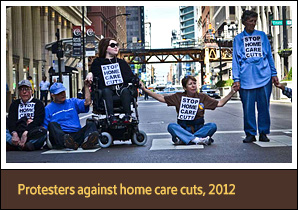ExhibitionReform and Reaction
- A physician examines an elderly patient, ca. late 20th century

A Public Health Service physician examines an elderly patient in a home setting, ca. late 20th century
Courtesy National Library of Medicine
The United States confronts problems of accessibility and quality of health care for military veterans, the disabled, and the elderly. Citizen groups continue to demand our attention to these challenges.
- Protestors against home care cuts, 2012

Fifteen protesters, including three in wheelchairs, were arrested during an action against state cuts to home care services, Chicago, 2012
Courtesy Service Employees International Union
Between 2000 and 2030, it is estimated that the population of people over 65 in the United States will double, reaching 72.1 million. The number of people needing long term and home care services will also increase. Citizen groups, including seniors, the disabled, and home care providers, are organizing to ensure adequate support and funding for the needs of elderly and disabled people.
- Veteran Mark Howey at a forum, 2014

Veteran Mark Howey participates in a public forum on the Veterans Affairs hospital crisis, Phoenix, AZ, May 9, 2014
Courtesy Laura Segall/Getty Images
As the numbers of U.S. war veterans requiring health care grew in the 2000s, the nation confronted a crisis in the veterans’ hospital and health systems. Veterans, their families, and supporters have organized to demand high quality medical care for all who have served.





